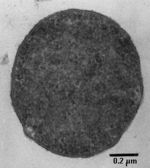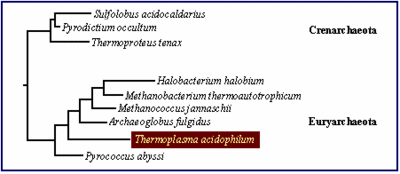Thermoplasma acidophilum
A Microbial Biorealm page on the genus Thermoplasma acidophilum
Classification
Higher order taxa
Cellular organisms;Archaea; Euryarchaeota; Thermoplasmata; Thermoplasmatales; Thermoplasmataceae; Thermoplasma acidophilum (1)
Genus
Thermoplasma acidophilum
|
NCBI: Taxonomy |
Description and significance
'Thermoplasma acidophilum' is a thermophilic heterotrophic prokaryote, they usually grow in mass colony covered in their “S-layer”. “Thermoplasma acidophilum is among the most acidophilic organism known.” They grow at 55-60°C and favor a really low pH of 0.5-4; (2) It is found and first isolated from self-heating coal refuse piles and solfatara fields. (3)
“Microbial physiologists and structural biologists have long been fascinated by the ability of this microorganism to grow at high temperatures and low pH without the structural protection of a conventional cell wall”, they are specially interest in the protein these organism have because common protein get denature under the acidic and hot environment Thermoplasma acidophilum live in. By determining and studying the genome sequence of this organism, we can have better understanding in protein folding and degration which led to seek more complete representation of the proteins involved in different metabolic pathways. (3)
Genome structure
Thermoplasma acidophilum’s genome contain special gene that allow this organism to survive in an environment similar in temperature and acidity to hot vinegar.(4)
The genome is a single circular chromosome and was sequenced using a new strategy called "shotgun sequencing".It is one of the smallest microbial genomes ever sequenced.(3)
“The genome of the organism consists of a single circular chromosome of 1.56 Mbp, containing 1509 ORFs. These identify Thermoplasma as a typical euryarchaeon with a substantial complement of bacterial-related genes. However, massive lateral gene transfer appears to have occurred between Thermoplasma and Sulfolobus solfataricus, a phylogenetically distant crenarchaeon inhabiting the same environment.”(2)
Cell structure and metabolism
Species of the genus Thermoplasma lack rigid cell wall, but are only delimited by a plasma membrane, it is “devoid of protective outer shells (S-layer, cell wall), yet maintains a near-neutral cytosolic pH.” (4)
“The lipid composition of T. acidophilum has been the subject of several investigations. This work has revealed the presence of large polar lipids, often glycosylated with glucose, mannose and gulose, phosphorylated, or both, forming phosphoglycolipids (5). These unusual lipid compositions help the organism survive under these otherwise harsh conditions of temperature and pH by restructing proton flow across the membrane more efficiently than non-branched lipids (6)”
T. acidophilum is able to gain energy in several ways, either anaerobically by sulphur respiration or as a scavenger in extreme environment.
In Thermoplasma, “glucose degradation proceeds by a non-phosphorylated variant of the Entner–Doudoroff pathway, in which the first step is catalysed by glucose dehydrogenase. The acetyl-CoA produced in this pathway enters the oxidative tricarboxylic acid (TCA) cycle.” (the presence of enzyme require for this pathway had already been experimentally confirmed), the presence of glycolysis/gluconeogenesis has not yet been confirmed due to the absence of phosphofructokinase and fructose in this organism.(7)
Ecology
Thermoplasma acidophilum plays an important role in the ecosystem, they act as scavenger of those extreme environment. “It has adapted to scavenging nutrients from the decomposition of organisms killed by the extreme acidity and requires yeast, bacterial or meat extract when grown in culture.”(3)
The study and research on Thermoplasma acidophilum indicate that an aqueous extract of coal refuse will serve as a nutrient source this the first step leading to the discovery of the materials in coal refuse which support its growth. Indeed, the coal refuse material provides nutrients for the growth of a wide variety of microorganisms and could be a source of new growth factors.(8)
Pathology
None of the archaea organism include Thermoplasma acidophilum had known to cause pathogen to human being.
Application to Biotechnology
“The 20S proteasome from T. acidophilum caught scientist attention recently because it's proteolytic mechanism is common between the archaebacterial and the eukaryotic forms of the enzyme which is clinically relavent.” (9)
In higher eukaryotes, proteasome is involved in housekeeping and protein level regulation. Further understand of chemical mechanism of this enzyme can help us to understand disease cause by the mutation of protesomes such as cystic fibrosis, Angelman's syndrome, Parkinson's disease and Liddle syndrome (10).
“Dysregulation of this enzymatic system may also play a role in tumor progression, drug resistance, and altered immune surveillance, making the proteasome an appropriate and novel therapeutic target in cancer.”(1)
Current Research
1) “Large chunks of DNA which have been borrowed from other species of microbe and incorporated into the chromosome of acidophilum. The genes are believed to come from microbes and bacteria that share the same environmental niches, like the soil near hydrothermal sites.”(11)
2) Ubiquitin found in the archaebacterium Thermoplasma acidophilum strongly suggests that ATP-ubiquitin-dependent proteolysis is a cellular function that developed early in evolution.(13)
3) Tremendous amount of research had been made on 20S proteasome of T.acidophilum, because this enzyme is common in higher eukaryotic organism and can play an important role on medical research.(12)
References
1. NEWT/ NCBI
2. http://wwwex.biochem.mpg.de/baumeister/genome/
3. Don Cowan,Nature 407, 466-467,28 September 2000
4.Cedric F.V. Hobel, Sigillum Universitatis Islandiae, Access to Biodiversity and new genes from thermophiles by special enrichment methods, 2004
5. Shimada et al, 2002
6. Baba et al, 2001
7.Energy Metabolism in T. acidophilum,http://wwwex.biochem.mpg.de/baumeister/genome/metabol.htm
8. B.B. Bohlool and T.D. Brock, University of Wisconsin, Madison, T.acidophilum in coal refuse material, 25 March 1974
9. Wlodawer, 1995
10. Vu et al, 2000; Schwartz et al, 1999
11.Bijal P. Trivedi, T. acidophilum living the hot, acidic life, Genome News Network Sep 29, 2000
12. Keiji Tanaka and Tomoki Chiba, The proteasome: a protein-destroying machine, The Tokyo Mtropolitan Institute of Medical Science, 1998
13. Wolf S, Lottspeich F and Baumeister W, Ubiquitin found in the archaebacterium Thermoplasma acidophilum, 1993 Jul 12
--chwon 22:00, 29 April 2007 (UTC)
Edited by student of Rachel Larsen and Kit Pogliano


